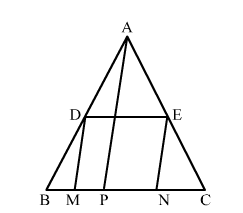P is any point on the side BC of a ∆ABC. P is joined to A. If D and E are the midpoints of the sides AB and AC respectively and M and N are the midpoints of BP and CP respectively then quadrilateral DENM is
(a) a trapezium
(b) a parallelogram
(c) a rectangle
(d) a rhombus

Given: In ∆ABC, M, N, D and E are the mid-points of BP, CP, AB and AC, respectivley.
In ∆ABP,
$\therefore B M=\frac{1}{2} A P$ and $B M \| A P$ (Mid-point theorem) ...(i)
Again, in ∆ACP,
$\because E$ and $N$ are the mid-points of $A C$, and $C P$, respectively. (Given)
$\therefore E N=\frac{1}{2} A P$ and $E N \| A P$ (Mid-point theorem) ...(ii)
From (i) and (ii), we get
BM = EN and BM || EN
But this a pair of opposite sides of the quadrilateral DENM.
So, DENM is a parallelgram.
Hence, the correct option is (b).
